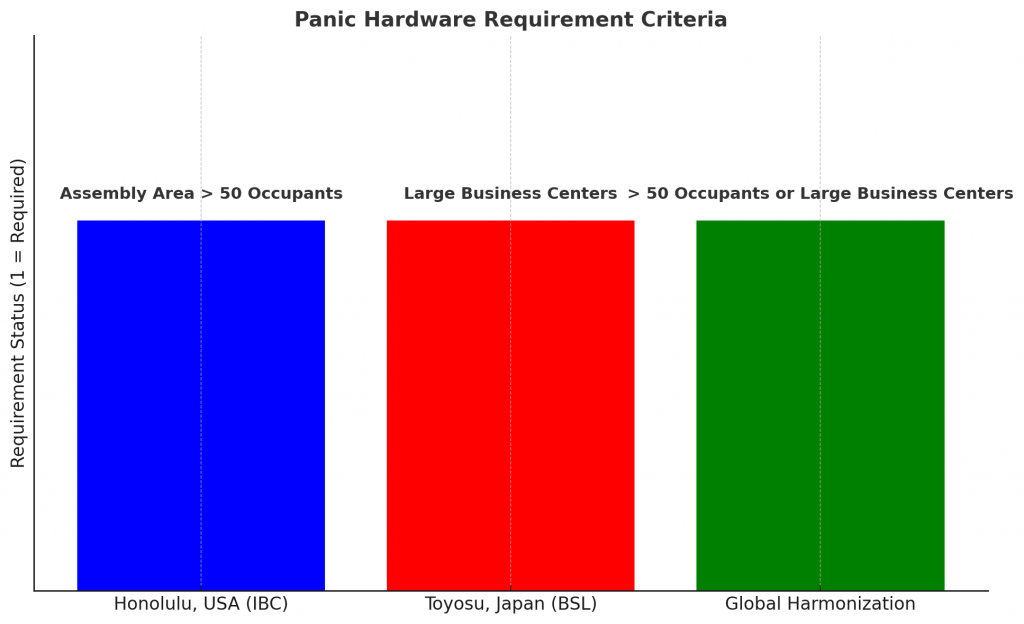General Definitions:
- IBC (International Building Code, USA):
- Section 1010.1.10 requires panic hardware on exit doors in assembly or high-occupancy areas where the occupant load exceeds 50. It ensures quick egress in emergencies by allowing doors to open easily without keys or special knowledge.
- BSL (Building Standard Law, Japan):
- Article 28 mandates panic hardware in large offices and business centers to promote life safety during emergencies, particularly where high occupant densities are anticipated.
Comparison Table:
| Criterion | IBC (USA) | BSL (Japan) |
| Panic Hardware Requirement | Required for exit doors serving areas with >50 occupants in assembly use | Required in large offices and business centers with high occupancy |
| Basis for Requirement | Occupant load and assembly occupancy classification | Size and function of building as a high-traffic business use |
| Scope of Application | Applies primarily to assembly areas within offices | Applies to entire buildings with dense office functions |
| Compliance and Enforcement | Local enforcement per IBC Section 1010.1.10 | National enforcement under BSL Article 28 |
| Flexibility and Adaptability | Specific thresholds for occupant load and use type | More general but strict application in large commercial settings |
| Testing and Certification | UL 305 compliant hardware | Japanese Industrial Standards (JIS) for emergency door hardware |
Key Differences:
- IBC: Applies to designated assembly spaces with clear occupant thresholds.
- BSL: Applies broadly to large-scale office or commercial buildings without specific load count.
Case Study:
5-Story Office Building
- Honolulu, USA (IBC):
- Panic Hardware: Required on exit doors from assembly rooms with more than 50 occupants.
- Toyosu, Japan (BSL):
- Panic Hardware: Required throughout the building if classified as a large business center.

Global Approach:
- Unified Panic Hardware Criteria:
- Define international thresholds based on both occupant load and building type.
- Risk and Function-Based Guidelines:
- Combine IBC’s occupant load focus with BSL’s functional use case criteria.
- Global Certification Standard:
- Align UL and JIS product testing to validate compliance across jurisdictions.
- Collaborative Code Refinement:
- Coordinate international safety panels to periodically revise threshold values and definitions.
- Training and Public Awareness:
- Provide universal education for facility managers and design professionals on panic hardware applications and safety roles.
IBC Section 1010.1.10 — Panic and Fire Exit Hardware (2018 Edition)
| Section | Title | Requirement Summary |
|---|---|---|
| 1010.1.10 | Panic and Fire Exit Hardware | Required on doors serving Group A, E, or H occupancies with an occupant load ≥ 50, or where panic hardware is required elsewhere in the code. Hardware must be listed and labeled. |
| 1010.1.10.1 | Electrical Rooms with Equipment ≥ 800 Amps | Panic hardware required on doors serving rooms with electrical equipment rated 800 amps or more, where equipment is over 6 feet wide and contains overcurrent devices, switches, or control devices. |
| 1010.1.10.2 | Hardware Operation | – Panic/fire exit hardware must open the door with a single motion, without tight grasping, pinching, or twisting. |
- The unlatching must occur when applying a maximum of 15 pounds (67 N) force. | | 1010.1.10.3 | Unlatching | – Releasing the door shall unlock all latches simultaneously.
- Multiple-latching devices (top/bottom rods, etc.) must be released by one single operation.
- Panic hardware = releases without key or special knowledge, typically a push bar.
- Fire exit hardware = panic hardware tested and listed for use on fire-rated doors.
- Must comply with UL 305 (Standard for Panic Hardware).
- Manual bolts, chains, and surface bolts are not permitted on egress doors where panic/fire hardware is required.
In Japan, the Building Standards Law (BSL) and the Fire Service Act govern building safety, including aspects related to fire prevention and evacuation. While these laws encompass comprehensive fire safety measures, they do not contain a specific section directly equivalent to the International Building Code (IBC) Section 1010.1.10, which addresses panic and fire exit hardware requirements.
